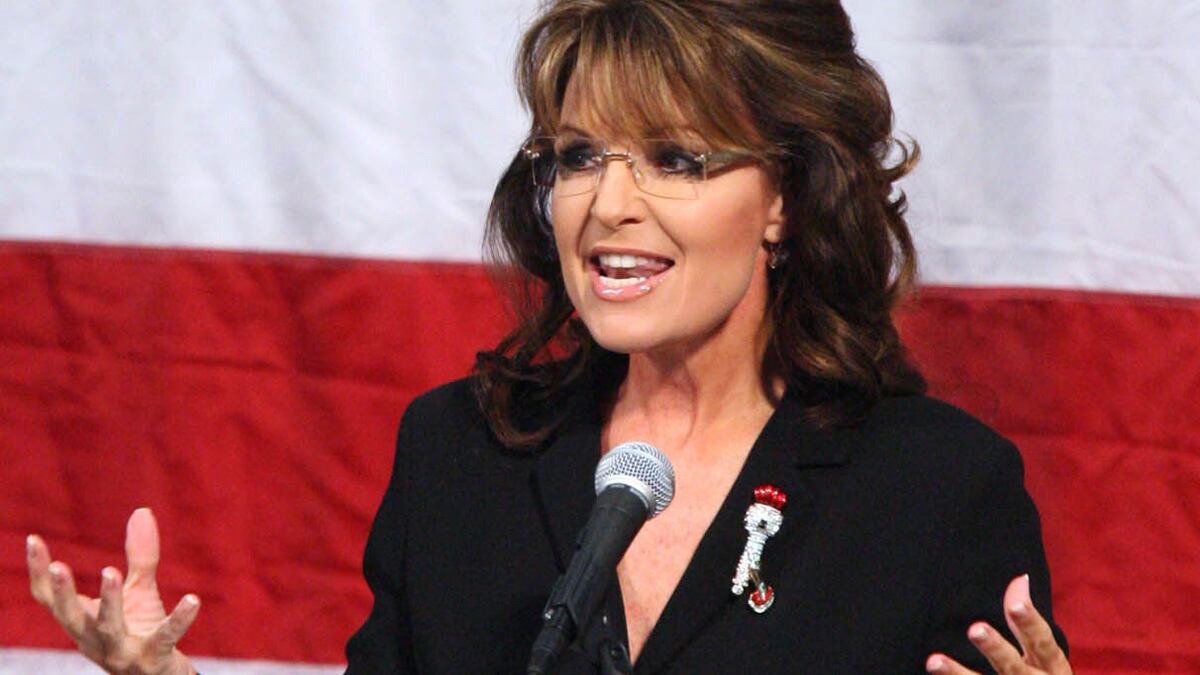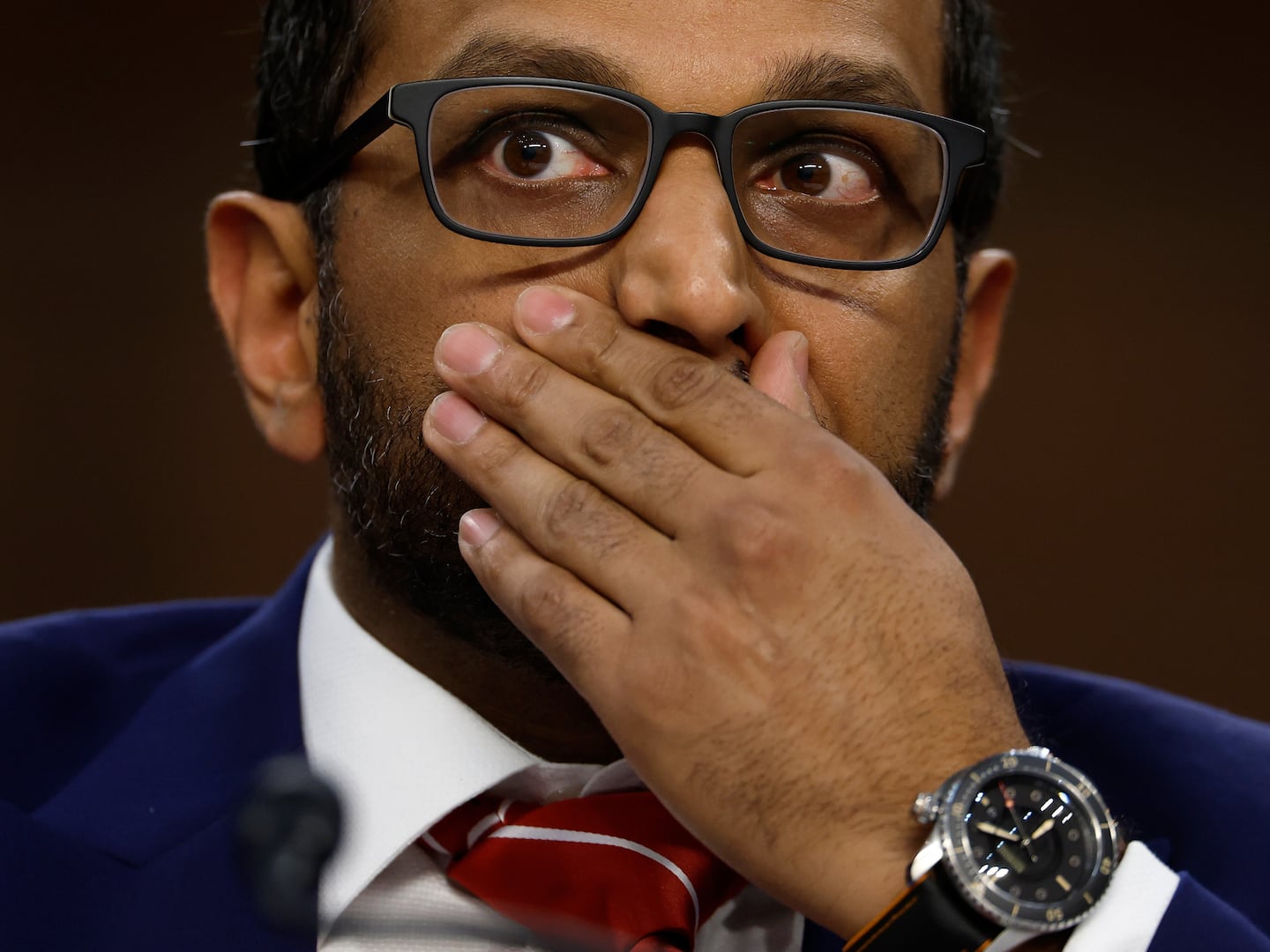Greeting supporters, touring the country in a bus, jabbing at your opponent, jousting with reporters, and taking unexpected questions from people on rope lines: These things are all part of a presidential campaign. On Day 2 of Sarah Palin’s bus tour she did all of that and still stayed coy about whether she would run.
On Monday, Palin toured historical sites around Washington, D.C., with her family, as reporters scrambled to keep up. Her team kept the schedule under wraps, leading some to wonder what a Palin presidential campaign would look like.
The former Alaska governor seemed to have given it some thought. “Definitely it would be unconventional and untraditional,” she said at an impromptu press conference in the parking lot of her Gettysburg hotel. “Yeah, it would have to be.”
At each stop Monday on her family vacation/testing the waters bus tour, Palin was greeted by supporters urging her to run, and by some reporters who were able to figure out her schedule. So far, she appears to be enjoying this untraditional tour immensely. It is clear that if she does run, her campaign won’t look anything like those of her rivals.
According to a source with knowledge of Palin’s thinking, the tour is a test of whether she can do it “her way,” which the source described as “nontraditional, low-cost, high-tech….The key is to be totally unpredictable and always keep her rivals off-balance.”
After two days on the road, Palin now realizes a campaign “could be fun and exciting,” the source said, and she’s getting “more into the swing of things” as she tours and realizes “the press is not hostile to her.” The source added that a “big part” of the tour was husband Todd Palin’s idea; he wanted to get “back onto the road, get into the swing of things, and see how the family pulled together.”
Even without a traditional press secretary or press notifications, Sarah Palin answered questions from the crush of journalists who caught up with her after she went for a run in Gettysburg, Pennsylvania.
Wearing a visor and shorts to greet supporters and tourists outside her hotel, she played it coy when asked whether she would rather not have the press with her: “I think I don’t have a choice,” she said, adding, “We don’t want to disrupt people on their trips and on their vacations and make it chaotic for these good folks.”

Palin’s tightly held schedule, she said, is about making “sure that people are aware of the good things in America that you really do need to be restored and appreciated.” This summer trip, she said, will highlight some of those “good things.”
Not all the questions were about her presidential aspirations. She also was asked what “big ideas” she had for the country. In response, she called for “big tax cuts and for job creators to be able to keep more of what they are earning and producing.”
But it is clear that the frenzy surrounding the will-she-or-won’t-she-run is where the press interest lies. Palin told reporters that she’s still deciding about whether to jump into the presidential field, saying, “It’s still a matter of looking at the field and considering much. There truly is a lot to consider before you throw yourself out there in the name of service to the public because it is so all-consuming.”
The GOP field “is already quite strong,” she said, though she added that she believes “there will be more strong candidates jumping in” and that “the field isn’t set yet, not by a long shot.”
Palin’s “One Nation” bus tour began Sunday at the Rolling Thunder motorcycle rally, and she started the day Monday with a trip to the National Archives in Washington with husband Todd, daughters Bristol, Willow, and Piper, and parents Chuck and Sally Heath to see the U.S. Constitution, the Declaration of Independence, and the Bill of Rights. Palin said it was “heartwarming” to see the documents and that she wished “every student in America could get here.” She stressed that her bus, painted with images of the Constitution, the Liberty Bell, and the a map of the United States, was not for a campaign but “a bus to be able to express to America how much we appreciate our foundation and to invite more people to be interested in all that is good about America.”
On the sidewalk outside the National Archives, the former governor had an interaction with a supporter that would be typical for the campaign trail. The man, Don Folden, described himself as a “black Republican” and asked Palin what she would do to attract more African-Americans to the GOP. She answered that she would ensure “jobs are created via the private sector, having the freedom to invest and prioritize. Doesn’t matter skin tone on that. We all need good jobs.”
But Folden wasn’t satisfied and pressed Palin, saying, “The Democratic Party uses racism and fear to keep us away from the Republicans.” He asked her how she would address the issue. Without missing a beat, she answered, “That is a shame, and we need you to do that.”
Unscripted moments that go badly can haunt a politician on YouTube during a campaign and into the future, but Palin’s ease with a rope line and her politicking skills are one of her best assets. A Palin campaign may not have a press bus or the more formal interviews that reporters crave, but her team will undoubtedly factor in added time for her to greet supporters and campaign not just in large rallies but one on one as well.
The next stop was Mount Vernon, to tour the home of George Washington, before moving on to Fort McHenry, site of the 1814 American victory against the British that inspired Francis Scott Key to write “The Star-Spangled Banner.” Palin and her family looked at the score for the National Anthem in the visitor’s center. Before touring the fort’s historic cannons, she praised one potential rival, Texas Gov. Rick Perry, and noted that he may still get in the race. “We have a lot in common,” she said.
“Competition breeds success,” Palin told reporters. “I would hope there is gonna be vigorous debate and a lot of aggressive competition even in our primary so that our voters have a good choice.”
She also made a slight dig at President Obama for saying Monday at Arlington National Cemetery that his “most solemn responsibility as president [is] to serve as commander in chief of one of the finest fighting forces in the world.” Answering a question about Memorial Day, Palin said, “This is the greatest fighting force in the world, the U.S. military. It’s not just one of the greatest fighting forces. And I sure hope our president recognizes that. We’re not just one of many. We are the best.”
After Fort McHenry, Palin headed toward Gettysburg, Pa., where she is expected to tour the Civil War battlefields Tuesday. At the impromptu press availability with reporters, she stayed on message, answering questions about her record as Alaska governor, talking about her work on oil and gas legislation, and explaining why she resigned before the end of her first term, citing “frivolous ethics complaints” that were “bankrupting” the state and her family. Compared to her stiff and sometimes combative interactions with the press during the 2008 presidential campaign, she seemed to be thoroughly enjoying herself and all the attention.Besides touring the Gettysburg battlefields, where she may lay a wreath, Palin also is expected to make a stop Tuesday at the Liberty Bell in Philadelphia. From there her tour heads north to New York City, with a possible stop at Ellis Island, and then on to the first primary state of New Hampshire.






